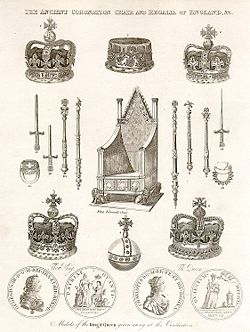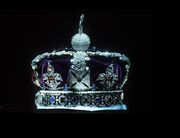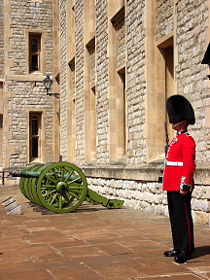Crown Jewels of the United Kingdom
2008/9 Schools Wikipedia Selection. Related subjects: British History; UK Politics & government
The collective term Crown Jewels denotes the regalia and vestments worn by the sovereign of the United Kingdom during the coronation ceremony and at various other state functions. The term refers to the following objects: the crowns, sceptres (with either the cross or the dove), orbs, swords, rings, spurs, colobium sindonis, dalmatic, armill, and the royal robe or pall, as well as several other objects connected with the ceremony itself.
Many of these descend directly from the pre- Reformation period and have a religious and sacral connotation. The vestures donned by the sovereign following the unction, for instance, closely resemble the alb and dalmatic worn by bishops, although the contention that they are meant to confer upon the sovereign an ecclesiastical character is in disrepute among Christian scholars.
Most, but not all, of the oldest set of Crown Jewels dating from the Anglo-Saxon period were lost by John of England near The Wash in 1216. The loss did not include the crown reputedly of Alfred the Great and that of Queen Edith which both survived until 1649. New items to replace those lost were made shortly afterwards and were soon joined by the addition of Welsh prince Llywelyn's coronet in 1284. This replacement set was stolen from Westminster Abbey in 1303 although most of the pieces, if not all, were recovered days later from the window of a London jeweller's shop with dire consequences for the owner. Since 1303, they have been stored in the Tower of London.
Oliver Cromwell melted down most of the Crown Jewels of his time after the establishment of the Commonwealth in 1649. Upon the Restoration of Charles II of England and Scotland in 1660, most of the regalia were replaced. Despite strenuous efforts to get them returned, apart from gold from the melted treasures and certain gem stones, the only intact pieces to survive from before the Civil War are three swords and a spoon. Some detail about what was lost can be found in the inventory made of the crown jewels by order of Parliament in 1649.
In the upper jewel house of the Tower:
The imperial crowne of massy gold, weighing 7lb. 6 ounces, valued at £1110. The Queen's Crown of massy gold, weighing 3;b. 10 ounces, £338, 3s 4d. A small Crowne found in an iron chest, the gold, £78, 16s 8d. The diamonds, rubies, saphires, &c £355. The forementioned Crownes since the inventorie was taken, are, according to order of Parliament, totalie broken and defaced
Some more ancient treasures were uncovered in the Palace of Whitehall:
Queen Edith's Crowne, formerly thought to be or massy gold, but upon trial found to be of silver gilt, enriched with garnetts, foule pearle, saphires and some odd stones, 50 1/2 ounces, valued at £16. King Alfred's Crowne of gould wyerworke, sett with slight stones, and 2 little bells, 79 1/2 ounces at £3 per ounce, £248 10s.
In the diary of Sir Henry Spelman, a parliamentarian at the time, he says of this crown, "It was of very ancient work, with flowers adorned with stones of somewhat plain setting". He added that the cabinet in which this last named crown was kept was inscribed:
Haec est principalior corona cum qua coronabantur reges Aelfredus, Edwardus
The crown attributed to King Alfred is usually considered to be synonymous with the relic referred to as "Saint Edward's Crown" which may have been attributed to Alfred at a later date, possibly the Reformation. It is the metal recovered from this crown that is considered to be incorporated in the recreated (1661) of the same name used in modern coronation ceremonies. Curiously, of Llywelyn's coronet - known to have been incorporated into the English crown jewels in 1285 - there is no mention. It is plausible that the "small crowne found in an iron chest" may have been this artifact, but the people at the time clearly thought this more likely to have been the crown of the boy king Edward VI.
The present British Crown Jewels are considered to be the most valuable and one of the largest jewellery collections in existence.
Crowns
The collection of Crown Jewels contains various crowns, some of which are used by every Sovereign, others being made personally for Sovereigns or for the Queens Consort. Typically the crown of a King has a slightly pointed arched top, while that of a Queen has a slightly bowed top.
St. Edward's Crown was made in 1661. Made of gold, its design consists of four crosses pattée and four fleurs-de-lis, with two arches on top. Surmounting the arches is a jeweled cross pattée. The Crown includes 444 precious stones. It is used through most of the coronation ceremony and is said to be made of the melted gold from King Alfred's Crown. It is noted by a number of British monarchs to be extremely heavy and difficult to wear. Queen Elizabeth II opted to use a stylised representation of this crown in images of the Royal Coat of Arms of the United Kingdom.
The Imperial State Crown was made in 1937 for King George VI, and was similar to the Diamond crown made in 1838 for Queen Victoria. The present Crown is made of gold and includes four crosses pattée and four fleurs-de-lis, with two arches on top, surmounted by a cross pattée. The Crown includes many jewels: 2,868 diamonds, 273 pearls, 17 sapphires, 11 emeralds, and five rubies. Among the stones are several famous ones, including the Black Prince's Ruby (actually a spinel) and the Cullinan II diamond, also known as the Lesser Star of Africa. It is worn after the conclusion of the Coronation ceremony when the monarch leaves Westminster Abbey, and also at the annual State Opening of Parliament.
The Imperial Crown of India was created when King George V visited Delhi as Emperor of India. In order to prevent the pawning of the Crown Jewels, British law prohibited the removal of a Crown Jewel from the country. For this reason, a new crown was made. Set with more than 6,000 diamonds, it is one of the heaviest crowns in the collection (at 34.05 ounces or 0.97 kg). It has since not been used.
The George IV State Diadem was made in 1820 for the coronation of King George IV, and was worn during the coronation processions of Queen Victoria and Queen Elizabeth II.
Queens consort, that is, wives of Kings, traditionally wore the Crown of Mary of Modena, Queen of King James II. By the beginning of the 20th century that small crown was in a decrepit state. A new European-style crown, flatter and with more arches than was traditional in British crowns, was manufactured for Queen Alexandra, consort of King Edward VII. A new crown, more akin to traditional British crowns, was manufactured for Queen Mary, consort of King George V, who was crowned in 1911. The final new consort's crown in the 20th century was manufactured for Queen Elizabeth, consort of King George VI, who along with her husband was crowned in 1937. All three consorts' crowns in turn included the famous Koh-i-Noor diamond. This latter Crown of Queen Elizabeth was also worn, minus its arches, by the by-then Queen Elizabeth the Queen Mother during Elizabeth II's coronation. It rested on top of the Queen Mother's coffin during her funeral in 2002.
Mary of Modena's Crowns
State Diadem—Worn by her on the way to her coronation and worn in such a way by Queens Consort down to the nineteenth century.
Coronation Crown—The crown with which she was actually crowned. Now in the Museum of London.
State Crown—Worn for the procession out of the Abbey and put to various other uses subsequently.
The Orb and Sceptres
Two Sceptres used by the Sovereign form a part of the regalia:
The Sceptre with the Cross was made in 1661, and is so called because it is surmounted by a cross. In 1905, it was redesigned to incorporate the Cullinan I, also known as the Great Star of Africa, which at over 530 carats (106 g) is the second largest cut diamond in the world after The Golden Jubilee. During the coronation, the monarch bears the Sceptre with the Cross in the right hand.
The Sceptre with the Dove was also made in 1661, and atop it is a dove symbolizing the Holy Ghost. While the Sceptre with the Cross is borne in the right hand, the Sceptre with the Dove is borne in the left. At the same time as the Sovereign holds both Sceptres, he or she is crowned with St. Edward's Crown.
The Sovereign's Orb, a type of globus cruciger, is a hollow golden sphere made in 1661. There is a band of jewels running along the centre, and a half-band on the top hemisphere. Surmounting the orb is a jeweled Cross representing the Sovereign's role as Defender of the Faith. For a part of the coronation, it is borne in the Sovereign's left hand.
Swords
Five Swords are used during the coronation.
The Jewelled Sword of Offering was made for the Coronation of King George IV. Its jewels are in the shapes of the floral symbols of the United Kingdom: the rose for England, the thistle for Scotland, and the shamrock for Ireland. It is the only sword actually presented to the Sovereign during the Coronation; the others are merely borne in front of the Sovereign.
The Sword of State is the largest sword in the collection, and is borne in front of the Monarch by the Lord Great Chamberlain both at the coronation and at the State Opening of Parliament.
The other three swords used are the Sword of Spiritual Justice, the Sword of Temporal Justice, and the Sword of Mercy. The latter has a blunt point and is known as Curtana.
Other items
The Ring was made for William IV's coronation in 1831. Previously, each Sovereign received a new ring to symbolize their "marriage" to the nation, though no new rings have been used since 1831.
When the Sovereign is anointed by the Archbishop of Canterbury, the anointing oil is poured from the Ampulla into the Anointing Spoon. The Ampulla is a hollow gold vessel shaped like an eagle, and the Spoon is a silver-gilt spoon set with pearls. The Spoon was bought by Clement Kynnersley, Yeoman of the Removing Wardrobe, for sixteen shillings when Cromwell ordered the destruction of the new regalia; the Spoon, probably dating from the thirteenth century, is thus the oldest element of the Regalia.
The Armills are gold bracelets said to symbolize sincerity and wisdom. Upon Queen Elizabeth II's coronation, a new set of gold armills was produced and presented on the behalf of various Commonwealth governments, namely: the United Kingdom, Canada, Australia, New Zealand, South Africa, Pakistan, Ceylon, and Southern Rhodesia.
The Tower of London
The Crown Jewels have been kept at the Tower of London since 1303 after they were stolen from Westminster Abbey. It is thought that most, if not all, were recovered shortly afterwards. After the coronation of Charles II, they were locked away and shown for a viewing fee paid to a custodian. However, this arrangement ended when Colonel Thomas Blood stole the Crown Jewels after having bound and gagged the custodian. Thereafter, the Crown Jewels were kept in a part of the Tower known as Jewel House, where armed guards defend them. They were temporarily taken out of the Tower in the Second World War. It was reported that they were secretly kept in the basement vaults of the Sun Life Insurance Company in Montreal, Canada, during World War II, along with the gold bullion of the Bank of England. However it has also been said that they were kept in the Round Tower of Windsor Castle, or the United States Bullion Depository. The Windsor Castle suggestion is the most probable since by law the Crown is not allowed under any circumstances to leave the country, and the risk of transporting the Crown Jewels abroad would have outweighed any advantage.


